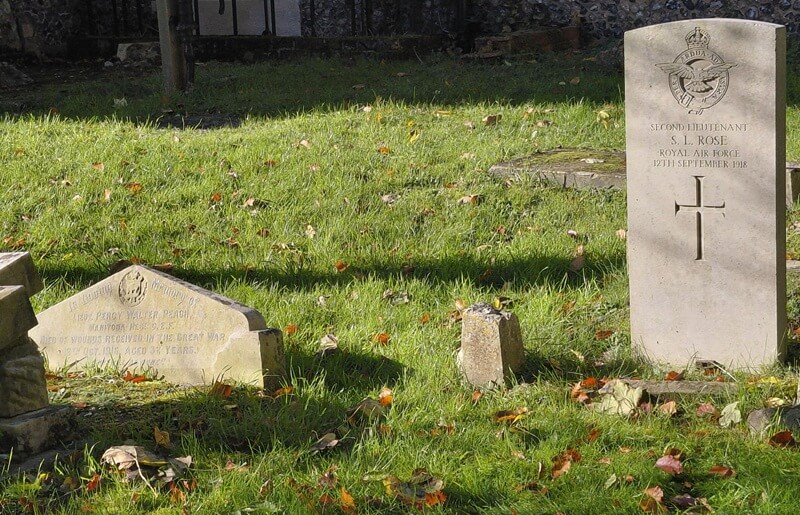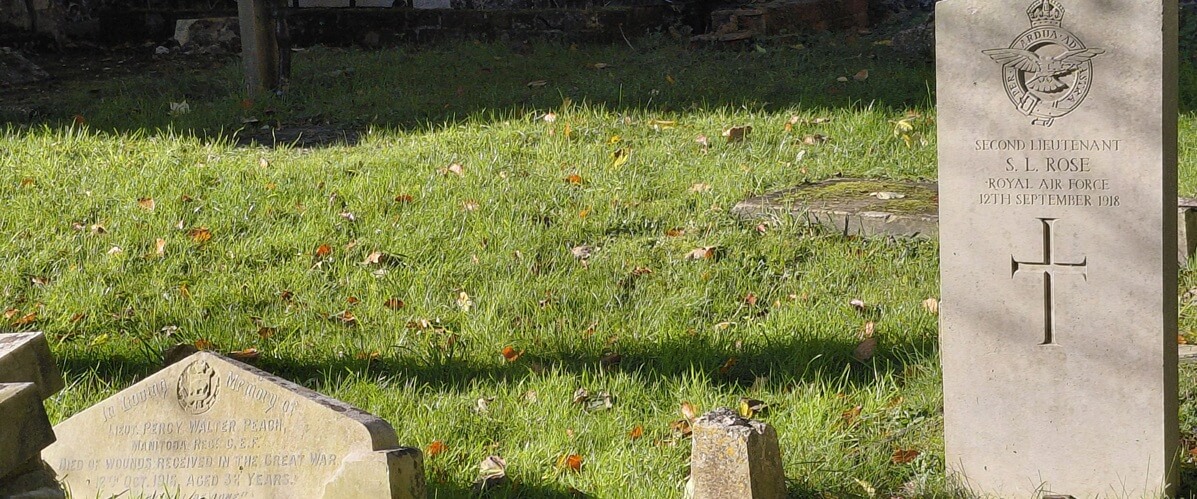by Alison Bailey
In a peaceful, sheltered corner of St Leonard’s Churchyard are found two WWI Canadian War Graves. Although born in Manitoba, Sidney Lasenby Rose, 31, who is buried here, had strong roots in Chesham Bois as his family owned mills and land locally. Percy Walter Peach, 32, in the neighbouring grave had only visited the area once. This was just weeks before his death whilst on leave to see his mother. These are their stories.

The Commonwealth War Graves in St Leonard’s Churchyard of Lt Peach, left and 2nd Lt Lasenby Rose, right, 2025
The Roses

The Rose family had lived here for many generations. Sidney’s great-grandfather George, the son of a Chesham baker, was the miller at Chesham Bois’ Amy Mill in the 1838 tithe records. His three sons, George, Henry, and Thomas expanded the business to include a new steam mill opposite (later Canada Works) and Lord’s Mill at Waterside.
As the business prospered, Sidney’s grandparents, George and Jane, moved into a grand house The Laurels, (later The Island) next to the Canada Works, around 1890. They also continued the family business of buying parcels of land around Chesham and Chesham Bois. By this time Sidney’s parents Henry John Fox Rose and Constance Scarlin Lasenby (from Weedon Hill Farm, Hyde Heath) had moved to a mill at Highbluff, Manitoba, Canada after their marriage in 1878. Sidney was born here 29 May 1887.
The family (now with eight children) returned to England in July 1892 setting up home in Houghton Regis where Henry started a business manufacturing poultry houses. Sidney attended Dunstable Grammar School. Following the death of Henry’s father in 1902, the family moved back to Chesham Bois to take over the mills. Here Sidney completed his training as a mechanical engineer.
2nd Lieutenant Sidney Lasenby Rose

Sidney returned to Canada in 1912 to work as an engineer. When war was declared, he enlisted as Private 3243 with the 3rd Canadian Mounted Rifles at Medicine Hat, Alberta. From his service papers we know that he was 5ft 7½” tall and had a 38” chest when expanded. His complexion was fair, his hair light brown and his eyes blue.
Just as Sidney was about to sail for France after six months training, he was released from active service for important war work. He had been asked to manage a factory after they had received a large contract to supply shells for the British Army. When the contract ended two years later, Sidney joined the Royal Flying Corp and trained in Toronto and Texas before returning to England to join the 81st Training Squadron at Gosport in November 1917.
He was commissioned to 2nd Lieutenant on 6 April 1918 and following the disbandment of the 81st, transferred to the 60th Canadian Training Squadron. After a brief home leave the previous week, on 12 September 1918 Sidney was undertaking advanced training at Scampton, Lincolnshire when his Sopwith aircraft suffered engine failure and crashed killing him instantly.
In respect of his wishes to have a quiet, private funeral, full military honours were declined with thanks. Nevertheless, the village turned out in force as recorded in the local paper: “the kindly thought of a family friend led to the grave being lined with flowers; friends sent roses in abundance; many friends and residents from the district were present in the churchyard when the young officer was laid to rest”.
Lieutenant Percy Walter Peach

Percy Walter Peach had been laid to rest in the neighbouring grave two years earlier. He was also a young officer in the Canadian Expeditionary Force. He had died in an English hospital from gunshot wounds received at the Somme and was buried close to the home of his widowed mother.
Percy was born in 1884 in Sutton, Cambridgeshire, the third of eight children to Joseph Peach and his wife Elizabeth (née Haddock). It was a prosperous household with four servants, including a nurse and a cook. All this changed when Percy was 12 years old and his father died. Like his elder brother Edward, Percy worked as a bank clerk after leaving Kings School in Peterborough.
In 1912, 26-year-old Percy sailed to Halifax, Canada. He settled in Winnipeg (55 miles from Sidney’s birthplace in Highbluff) where he found work as an accountant. Percy joined the Legion of Frontiersmen, a voluntary militia force, and served with them until 1915. On 24 June he enlisted in the 45th Battalion (Manitoba) as a Provisional Lieutenant.

From his service papers we know that he was 5ft 9” tall, weighed 172lb and had a 40” chest when expanded. His complexion was dark, his hair black and his eyes brown. He gave his mother as his next-of-kin, and her address as Eccleston, Parkfield Avenue, Amersham. Later service papers show that he was his mother’s main support and that prior to enlistment he had been sending her 25 Canadian dollars per month.
On 5 November 1915 Percy was appointed Acting Signalling Officer, still based in Winnipeg. He left Canada on 13 March 1916 on the SS Lapland and disembarked in England 12 days later. He was given leave of absence before reporting for duty on 12 May. It is assumed that he visited his mother in Amersham for the only time as he later informed the Paymaster that he had left his surplus baggage with her.
In August Percy proceeded overseas to France to join the 52nd Battalion (New Ontario) at the Somme. On 18 September he received gunshot wounds and was admitted to the No.8 Red Cross Hospital at Le Touquet and then transferred to No.2 Red Cross Hospital at Rouen. Here he was reported as dangerously ill; but a week later he was returned to England to the 1st London General Hospital at Camberwell. He remained there for 18 days before dying from his wounds on the night of 12 October 1916. His mother was buried in the same grave when she died in December 1946, aged 93.

